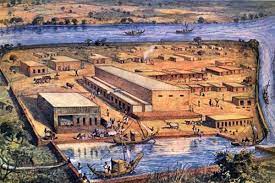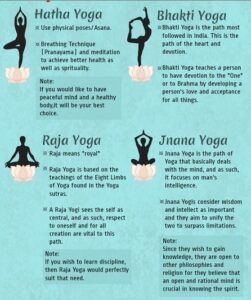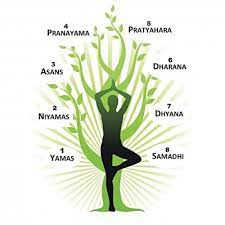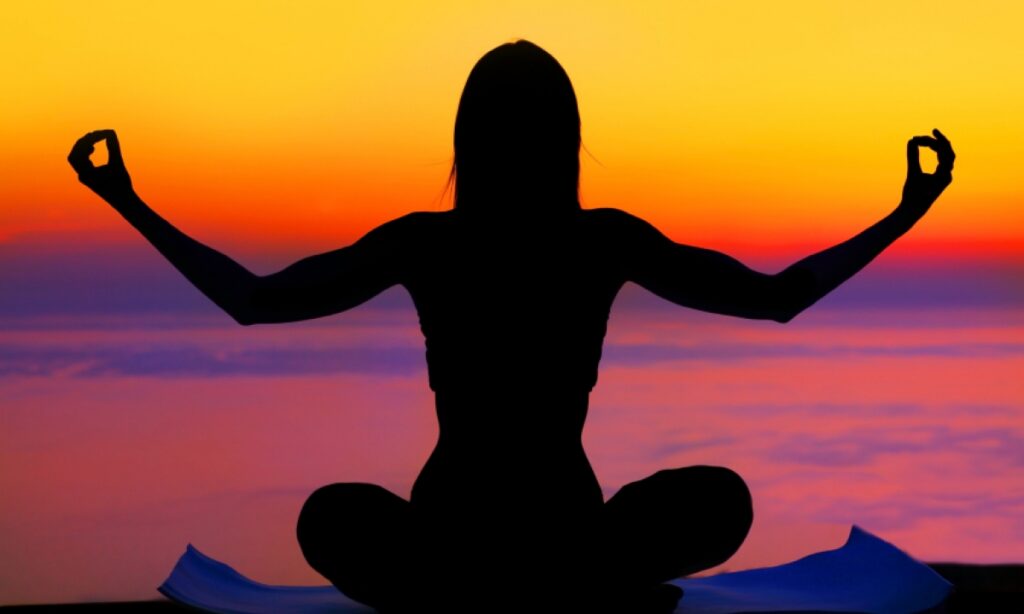Where does Yoga Come from?
-by Shivangi Shukla
–Reading Time – 7 min Approx
–Edited by – Srishti Bhattacharyya
व्यायामात् लभते स्वास्थ्यं दीर्घायुष्यं बलं सुखं।
आरोग्यं परमं भाग्यं स्वास्थ्यं सर्वार्थसाधनम् ॥
When it comes to being healthy, yoga is considered one of the best practices all around the world. It doesn’t only heal the body, but also works on our mind and soul. When practicing yoga, you come across different forms and postures. These postures help the body to be flexible, energetic and improve the state of mind. The word ‘yoga‘ originated from Sanskrit which means to unite. According to yogic practices, yoga helps unite man with nature. It is said to believe that yoga roots go to the very dawn of civilization. Yoga has taken the modern world by storm.
It is a thousand years old practice that has evolved. The Majority of the people have inculcated yoga in their morning routine. Yoga doesn’t adhere to any religion. It is a practice for inner well being. Wherever you go today, people keep talking about the numerous benefits of yoga and its importance in our daily life. One of the things which aren’t discussed much by people is where does yoga come from.

Where does Yoga come from? History of yoga:
The history of yoga goes way back to the Indus Saraswathi civilization. Several fossils have been found with figures performing yoga. This proves that yoga was practiced at the early stages of civilization.
Vedic Period:
The word ‘yoga’ was first mentioned in the ancient Indian text The Rig Veda. Around 1200 -1000 B.C the importance of breathing techniques was mention in The Atharva Veda.
Pre-classical Period:
The birth of Upanishads took place in this period. Upanishads are the elaborated form of Vedas. There are 108 Upanishads in total, out of which 20 Upanishads are about yoga. In these 20 Upanishads, the yoga techniques like pranayama, breathing techniques, meditations are mentioned.
Classical Period:
In this period, Bhagawad Gita came into existence. This manuscript is a conversation between Lord Krishna and Prince Arjuna. Lord Krishna preaches the concept of Karma Yoga (generous action), Bhakti Yoga (dedication and caring action), and Jnana Yoga (knowledge). Lord Krishna says, “Samatvam yoga uchyate” where ‘Samatvam ‘means balanced state and ‘Uchyate’ means said to be. According to Lord Krishna, Yoga is a balanced state of emotion, body and mind, and thought and intellect.
Lord Mahavir preached about finding freedom through meditation and attaining salivation whereas Lord Buddha taught about various yoga postures and ways to achieve enlightenment through meditation.
In this period, Maharishi Patanjali systematized the Yoga Sutra and disseminated the meaning and knowledge of yoga. This yoga is known as Raja Yoga. Maharishi Patanjali put together the eight limbs of yoga or the Ashtanga Yoga.
Post Classic Period:
This is the era when yoga was systematically practiced and the evolution of yoga continued. Many sages and philosophers continued to contribute to the teaching of yoga. Sages like Adi Shankaracharya had played a major role in teaching the science of yoga. He continued and developed Jnana Yoga and Raja Yoga. Hatha Yoga was very popular in this period too. Most of the Asans we practiced today are a part of Hatha Yoga. Tulsidas and Purandara Dasa also contributed to the science of yoga in this era.
Modern period:
21st Century Yoga has come a long way; now yoga is a part of the fitness regime. This evolution of yoga focuses more on physical well-being.
Swami Vivekananda was mainly responsible for the introduction of yoga to the western world. Yoga was introduced to the western world in the mid-nineteenth century and became an important part of the urban culture. In 1893, Swami Vivekananda spoke about Raja Yoga at the Parliament of Chicago.
Father of yoga:
According to scriptures, Lord Shiva who is also called ‘Adiyogi’, meaning “the first yogi”, is considered the father of yoga. It is said that Lord Shiva had disseminated his profound knowledge on Yoga, to the seven sages, at the bank of the Kanti Sarovar, a lake in the Himalayas. These ‘Saptarishis’, or the seven rishis, sat there for 84 years, waiting to learn from Shiva. Shiva was impressed and became the ‘Adi-guru’ and taught about yogic science to these sages. These seven sages carried the knowledge of yogic science and spread this knowledge in seven different directions.
Thousand years later, Maharishi Patanjali saw that these Yoga Sutras were too complex to understand. He then went on to compile and format all the sutras of yoga in a certain way. Thus, Maharishi Patanjali is named the father of modern yoga.
Types of yoga:
Practicing yoga is a combination of bliss and enlightenment. Yoga can be classified into four groups – Karma Yoga, Bhakti Yoga, Jnana Yoga, and Raja Yoga. Each of these paths of yoga has its own significance.
Karma Yoga:
Karma yoga can be practiced anywhere. In this path of yoga, you need is a zeal to serve selflessly. A Karma yogi eliminates the ego and purifies the heart. This path is dependent on the attitude of a person, not the action.
Bhakti Yoga:
Bhakti yoga is where you surrender yourself to God. This path of yoga is practiced by offering prayers to the divine, chanting names of Gods, and participating and performing rituals.
Jnana Yoga:
Jnana Yoga refers to the yoga of knowledge. This is one of the most direct paths of yoga where a yogi uses the mind to analyze its own nature through the right inquiry.
Raja Yoga:
Raja Yoga includes the three dimensions of human existence which are physical, mental, and spiritual state. This path of yoga involves both yoga of mind and body control. Raja Yoga describes both the goal of yoga and techniques to achieve it. It includes Hatha Yoga and Ashtanga Yoga. Hatha Yoga is a form of yoga consisting of yoga postures, breathing techniques, and cleansing exercises. This helps a person to control their mind, body, and senses.
Ashtanga Yoga is a Sanskrit term. ‘Astha’ means eight and ‘ang’ means limb. Ashtanga yoga is the yoga of the eight limbs. Ashtanga yoga was formulated by Maharishi Patanjali as eight limbs of yoga.

Eight limbs of Ashtanga yoga are:
- ‘Yama’ means principles or morals. This involves Ahimsa (non-violence), Satya (truthfulness), Asteya (non-stealing), Brahmacharya (chastity), and Aparigraha (non-possessiveness).
- ‘Niyama’ means moral observances such as purity, contentment, self-discipline, self-study, devotion.
- ‘Asanas’ means yoga postures.
- ‘Pranayama’ means breathing techniques to control the life force.
- ‘Dharana’ means concentration.
- ‘Samadhi’ means enlightenment or bliss.
Benefits of yoga:
Yoga is so popular worldwide that more than half of the world’s population has adopted yoga as part of their routine. It helps in the overall development and brings flexibility to the body and calmness to the mind. It not only helps you to get in shape or physically fit but works on your mind too. Since yoga is practiced in different ways it’s easy for a beginner to practice yoga.
Practicing yoga brings a sense of self-awareness. It strengthens intuition and relieves stress. The sole purpose of yoga is to heal both physical and mental illnesses. Yoga, if practiced with a systemized form, offers happiness, calmness, and harmony to a person. It is not just an exercise or form of physical activity, Yoga is a lifestyle which when performed or practiced well leads to enlightenment. Adopting yoga as a lifestyle heals a person from within.
International yoga day:
Yoga is now practiced worldwide by millions of people; different yoga studios and ashrams perform and teach different styles of yoga. This popular practice is a vast subject to study. It is a gift from ancient India to the world. In the year 2014, current Prime Minister Narendra Modi proposed the idea of an International Yoga Day which was accepted by the general assembly of the United Nation. International Yoga Day is celebrated on 21st June every year from 2015 onwards.
-by Shivangi Shukla
Dear Reader, Hope you liked the post. If you think our initiative “The Creative Post” is worth supporting, then please support us by paying the amount you think we are worthy of. We believe, the value of content should be decided by the consumer. Hence we request you to evaluate our worth and pay accordingly by Clicking Here.


